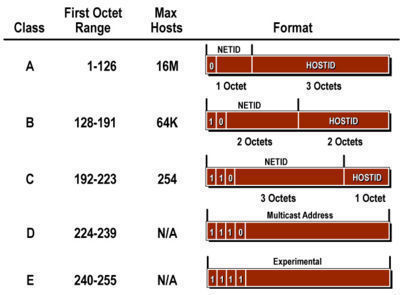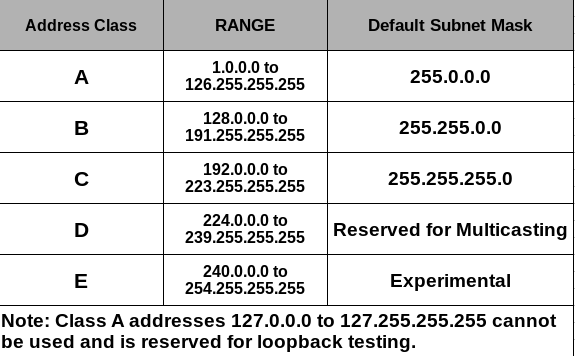Explain the Different Classes of Ip Address
So that the first octet ranges from 1 127. A B C D and E.
The broadcast address can also be 255255255255255.

. Unicast IP addresses are used to direct packets to a specific host. Each class has a range of valid IP addresses. Class D has IP address range from 224000 to 239255255255.
The order of bits in the first octet determine the classes of IP address. The classes of IPv4 addresses. This is an address of a single interface which are used for one-to-one communication.
4 Class D address. 172165513 because this is a Class B address the first two numbers 17216 represent the network part while the remainder of the address represents the host part 5513. There are mainly four types of IP addresses.
The terms public and private relate to the network location that is a private IP address is used inside a network while a public one is used outside a network. The range of IP address from Class A to Class B. There were three address classes to chose from.
1 Class A address. In classful addressing an IP address in class A B or C is divided into netid and hostid. The 32 bit IP address is divided into five sub-classes.
These classes are A B C D and E. For example if we have a class C type of LAN 1921681124 then the broadcast IP will be 1921681255. There are 4 types of IP Addresses- Public Private Fixed and Dynamic.
Example for a Class B IP address. But some of these addresses are not used for communication purpose. Class C gives 2097152 2 21 Network addresses and 254 2 8-2 Host addresses.
The different classes of the IPv4 address are the following. ICANN is responsible for assigning IP Addresses. A broadcast IP has all 1s in the Host part.
In order to deal with the exhaustion of IPv4 addresses. Public IP address A public IP address is an Internet Protocol address encrypted by various serversdevices. In 1981 according to most-significant octet IPv4 addresses are defined in five different classes.
Class A networks accounts for half of the total available IP addresses. Although in IPv4 we have 4294967296 unique addresses. The class A address only include IP starting from 1xxx to.
Class B networks have a first bit value of 1 and a second bit value of 0 in the first octet. IPv4 address is divided into two parts. If you look at the table you may notice something strange.
Class A B C D and E. 5 Class E address. The classes of IPv4 addresses.
All Class B networks have their first bit set to 1 and the second bit set to 0. When a machine on a network uses to send the packet to all it uses 255255255255 in the destination IP address of a message header. Multicast IP addresses are used for one-to-many communication.
4 Class D address. IP address with a first octet starts from 192. Classes D and E are reserved for multicast and experimental purposes respectively.
The 32 bit IP address is divided into five sub-classes. The device with the IP address 11543 is not on the same network because the first number of its IP address is different. All the five classes are identified by the first octet of the IP address.
IP Address Types. Each of these classes has a valid range of IP addresses. Broadly the IPv4 addressing system is divided into five classes of IP address.
For humans the easiest way to distinguish between different address classes is to use the first decimal number in the IP address. The IP address with a first octet from 128 to 191 is part of this class. The first bit of the first octet is always set to zero.
Their private IP addresses and their public IP address. A device with the IP address of 17216. 3 Class C address.
Class C is used for small to middle size networks. Class D addresses were designed for multicasting. There are three different types of IP addresses within this classification.
Very first four bits of the first octet in Class D IP addresses are set to 1110 giving a range of. The different classes of the IPv4 address are the following. It is used for medium size networks.
3 Class C address. In c1assful addressing a large part of the available addresses were wasted. Version 4 TCPIP defines five classes of IP addresses.
A block in class C is probably too small for many organizations. Example for a Class A IP address. 2 Class B address.
1 Class A address. Up to 20 cash back Every individual or business with an internet service plan will have two types of IP addresses. IPv4 address is divided into two parts.
The IP protocol defines five different address classes. Among them public and private addresses are derived from their local network location which should be used within the network while public IP is used offline. Class E is experimental so you can just forget about those too.
In dotted decimal notation that makes 128000 to 19125500 as Class B networks. Public Private Static. Each of these classes has a valid range of IP addresses.
The order of bits in the first octet determine the classes of IP address. Classes D and E are reserved for multicast and experimental purposes respectively. The first three classes vary the portion of the address devoted to the network ID and the host ID.
Among them public and private addresses are based on their location of the network private which should be used inside a network while the public IP is used outside of a network. Types of IP address. A B or C corresponding to 8-bit 16-bit or 24-bit prefixes.
Let us see all these types of IP address in detail. IPv4 is the original version of IP addresses which is still widely used today in all computer networks. These parts are of varying lengths depending on the class of the address.
5 Class E address. Class C IP address format is. The value of the first octet.
Class D is for multicast addresses which is something else entirely. There are 16384 possible Class B networks. 2 Class B address.
Based on the following rules IP addresses are categorized into five. In a Class B network the first 16 bits are the network part of the address. 6 rows IP address classes.
10 Different Types of IP Addresses Used in Computer Networks 1 IPv4.

Different Classes Of Ip Address And Its Range And Subnet Mask Youtube


Comments
Post a Comment